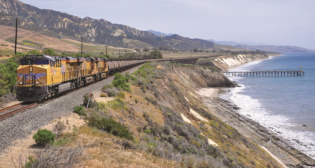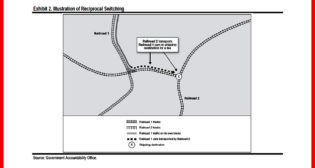
Rock-Solid Support
Written by Carolina Worrell, Senior Editor
Image Courtesy of Plasser American
RAILWAY AGE, NOVEMBER 2023 ISSUE: High-production, computer-driven track machines and inspection vehicles perform one of the most critical of maintenance-of-way functions: keeping ballast in a state-of-good-repair to provide a smooth-running surface with excellent drainage.
Track is only as good as the ballast holding it in place. Ballast serves many purposes, the most important of which is drainage. There are high-production machines and attachments (ballast gates, for example) and computerized inspection vehicles to perform all these tasks, built (and sometimes operated under contract) by multiple suppliers to help dump, spread, tamp, profile and clean ballast, helping to keep track in its place.
Railway Age contacted the following suppliers to find out about their latest technologies and what their customers are looking for, as well as the state of the market: Brandt Road Rail; BTE (Ballast Tools Equipment); DymaxRail; HRSI (Herzog Railroad Services); Knox Kershaw; Loram Technologies, Inc.; Miner Enterprises; Plasser American; RCE (Rail Construction Equipment Co.); Ontario Trap Rock; Mitchell Railgear; and Rhomberg Sersa North America (RNSA). Following is a roundup of offerings from suppliers who responded to our inquiries.
BTE
Mud Spots and other fouled ballast defects that are not repaired in a timely manner can lead to future defects and can cause track components to deteriorate rapidly and compromise the stability of the track structure, BTE tells Railway Age.
Remediation of these FRA 213 defects has traditionally required a crew of six-plus personnel utilizing multiple machines, including an undercutter, dump truck, tamper and regulator.
BTE has developed a new approach to remediate Federal Railroad Administration (FRA) fouled ballast defects using a one-man crew equipped with a single BTE Hi-Rail Excavator and the new BTE CRIBBER and related work attachments.
According to the company, the BTE CRIBBER attachment is derived from BTE’s industry leading trencher-style undercutter and utilizes the company’s proprietary carbide-protected cutting chain, which is proven to withstand wear even in the toughest of conditions. Its continuous action, BTE says, allows for a faster, more efficient removal of ballast and debris. The CRIBBER utilizes chain guarding to protect against damage to the rails and ties while in use.
The introduction of the BTE CRIBBER, BTE says, now allows railways to utilize a single operator and a BTE Hi-Rail Excavator outfitted with a bucket, CRIBBER, dump cart and tamping attachment to completely remediate FRA fouled ballast defects. The BTE’s Fouled Ballast Solution requires fewer machines and personnel, as well as less track time, according to the company.
“With a single operator and Hi-Rail Excavator equipped with BTE’s suite of attachments, railways can now clean mud spots and remediate fouled ballast defects in a fraction of the time at a fraction of the cost,” BTE says.
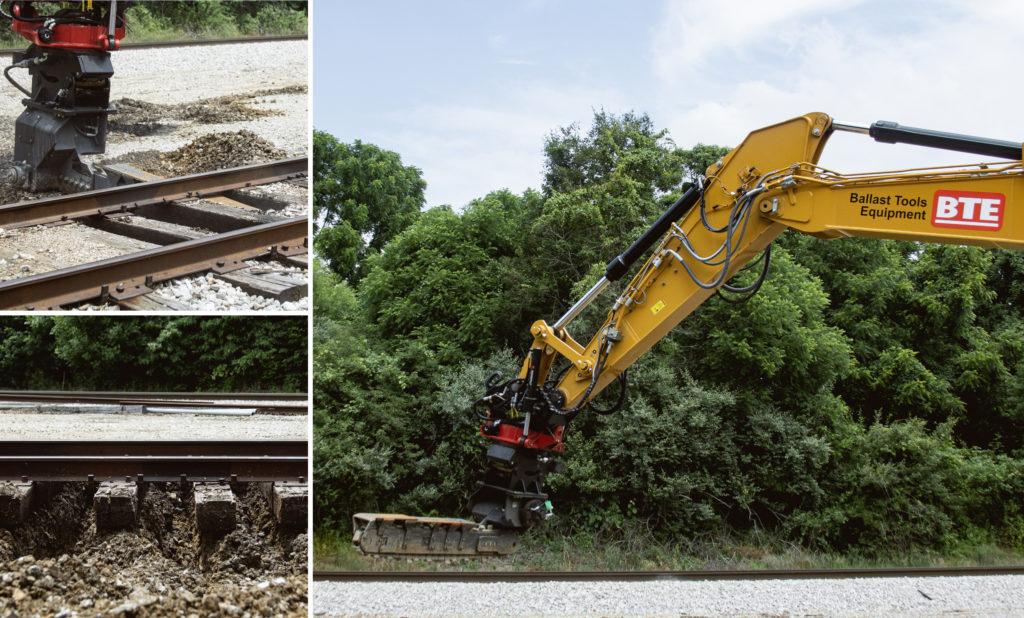
Miner Enterprises
For more than 40 years, Miner Enterprises’ AggreGate® MOW ballast outlet gates have brought reliability and flexibility to MOW operations, the company tells Railway Age.
The stand-alone solar-powered AggreGate® with car-mounted work lights for nighttime ballasting enables independent operation of individual cars anywhere within the ballast train. This, Miner Enterprises says, “boosts MOW agility and efficiency by eliminating the need for grouping manual and automatic cars.” Optional remote wireless control systems enable specific car and gate selections for up to 1,000 cars.
AggreGate outlet gates feature large guillotine door openings designed to stop ballast flow with minimum effort, ballast shutoff capabilities at switches, crossovers and bridges, and single- or double-door control options. According to Miner Enterprises, the AggreGate can effectively dump ballast inside, outside or on both sides of a rail simultaneously. Standard electric, air-powered and manual gate models are also available. All are suitable for both retrofit and new railcar systems, the company notes.
The new stand-alone, solar-powered Miner Lighting System features four energy-efficient LED lights mounted on the railcar’s under-carriage. Each system supports low-visibility and night-time ballast operations. The photovoltaic system includes a solar array, batteries, two switches and a lighting controller with a temperature compensation feature designed to ensure the system is properly charged in hot, as well as cold environments. The Miner Lighting System is available as a stand-alone system and as an option with all Miner ballast/MOW outlet gates and rapid discharge systems.
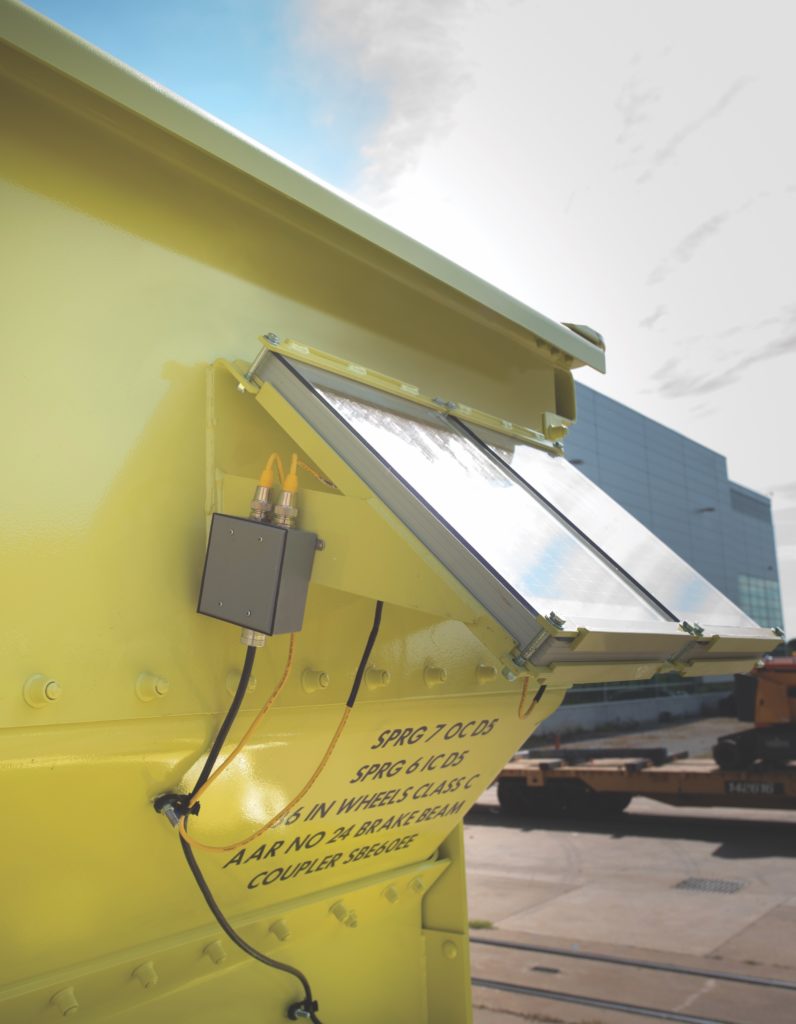
Miner’s solar-powered AggreGate MOW ballast outlet. (Miner photo)
Plasser American
“It has been proven that ballast cleaning will increase the time between tamping maintenance cycles resulting in cost savings in maintenance and increasing track availability,” Plasser American tells Railway Age. The company’s large machine portfolio is “designed to meet individual demands and increase the efficiency of the team at work.”
According to Plasser American, the biggest undercutter in the U.S. with “unbeatable performance” is the RM802. This high-production ballast undercutting/cleaning machine is especially designed to work on track with pre-dumped ballast. With the RM802, production rates of up to 2,000 feet per hour are achievable, the company says.
The RM80-800 is a high-performance ballast cleaning machine in articulated design with a powerful cutting chain and a high-capacity screening system that ensure high working speeds, even in fouled, encrusted ballast. The RM80-800 is equipped with a track lifting and lining device that allows the track to be lifted and to be shifted laterally as required to clear track side obstacles.
When asked about what customers are facing today, the company says, “The current market is up against issues of high inflation, a shrinking population of specifically skilled workers, and an increasing demand for more capacity. These pressures make the need for high quality work even more pressing.” Plasser American says it has “continued to strive forward in this machine space to develop new improvements and technology that raise the capabilities of the machines available for this work. “
The 09-2X DYNACAT, a heavy-duty, high-speed, and continuous action two-tie switch and production track-tamping machine, is equipped with its integral dynamic track stabilizer and a “perfect tool to face the above-mentioned challenges of low headcount and increased output,” Plasser says. While the satellite tamps and indexes two ties at a time during the actual work process, the machine’s main frame, with stabilizer system, moves smoothly and continuously at a speed determined by the operator.
“The Plasser American GRM4000 is a new product launch and the next step in the evolution of the GRM line of tamping machines,” Plasser tells Railway Age. This latest model offers a modified design with a two-tie tamping unit to significantly increase the production rate and improved weight distribution designed to be transported by road trucks or flat cars. Furthermore, the addition of the Autonomous Remote Stabilizer Upgrade Kit “links” the new GRM4000 remotely to the popular Plasser Dynamic Track Stabilizer PTS90C. This kit consists of two modules—one is installed on the existing stabilizer and the counterpart on an independent lead machine, such as a GRM4000. Once installed, the stabilizer can be fully controlled by the lead machine operator and requires no additional operator. This remote upgrade, Plasser says, keeps headcount low and performance high, while radar safety solutions ensure safe operation on track. Field tests proved the feasibility and safety of the new upgrade kit and delivered the expected results. “This new upgrade kit supports the industry’s push towards precision scheduled railroading by improving efficiency, safety and versatility during surfacing actions,” Plasser says.
“When pairing a strong and efficient ballast maintenance system with an advanced and heavy-duty tamping operation, more tracks can be maintained and available for peak performance. These machines, coupled with Plasser American’s decades-long proven track record of exemplary contracting services, provide the ultimate solution to ballast bed cleaning, inspection, tamping, and overall maintenance,” says Plasser American.
RCE
“The supply chain challenges that we’ve experienced the last several years have eased,” RCE tells Railway Age. “We have a strong demand for equipment heading into 2024 (sales, rental and leasing opportunities) as maintenance and rail restoration projects kick off.”
New technologies for the company include updates to RCE’s New Series Railavators and Series 5 P Swing Loader.
The new Series 5 P Swing Loader utilize a John Deere 544 P-Tier model machine with enhanced performance, efficiency, and comfort so customers can “hit the heavy jobs harder,” according to RCE. The new P-Tier wheel loaders provide spacious operator stations, including customizable ergonomic electrohydraulic (EH) controls, and streamlined electrical and hydraulic routing, making these “versatile and productive mid-size models the perfect match to take rail maintenance operation to the next level.”
The standard loader boom and housing has been replaced with a 200-degree turntable that allows the operator to accomplish swing crane functions. The main boom assembly retains its structural integrity allowing the Series 5 to accomplish wheel loader functions with 14,500 pounds of lift capacity. Equipped with the high traction axles, the Series 5 Swing Loader has enough drawbar pull to handle the positioning of continuous rail. “Whether working on or off rail, the Series 5 Swing Loader provides a powerful, safe machine that offers the reliability of John Deere wheel loaders and the ultimate in swing crane technology,” says RCE.
The Railavator—high rail excavator—is RCE’s most popular machine because of its quality and versatility. With its patented hydraulic powered retractable high rail, customers can take it anywhere they need it on and off track. The New Series 210P, 245P and 250P Railavators boast RCE’s new Ultra Life Axles. These drives are made of high strength alloy steel—two times more structural strength than existing cast iron final drives. Many rail maintenance operations require severe duty applications with high point loading. The Ultra Life Axles have overall increased axle bearing capacity and are rebuildable/repairable. The Ultra Life Axles have a three-year/unlimited hours warranty.
The New Series Railavators have many design enhancements, including a new hydraulic system. There are more components in the common manifold, which means less hoses, less separate components, and less joints to potentially leak. The F-N-R valves are now pilot operated instead of electrical coils, which makes for a more reliable design, the company says. The RCE team also updated the Railavator structure, including the high rail linkages and supports, extending support gussets and adding weight to the links and frames. These modifications, RCE says, reduce frame flexing and potential cracking. The main drive frame is aligned in all axes for drive components. The drive axle mounting has been changed for more strength and durability, as well as the axle mount and front/rear bumpers and tow points. The improved rotary manifold has a higher-pressure rating and longer life, and the push button monitor, which RCE says “customers rave about its intuitiveness and ease of use,” controls the high rail and all available attachments from inside the cab.
The 50G, 85G and 135P Railavators feature an adjustable lower track frame. When retracted, the machine is under the legal size for transit without a required permit. In work mode, the hydraulically operated frame expands to straddle the track.
RCE blends the appeal of John Deere’s newest 320 P-Tier backhoe with the needs of the rail industry. RCE equips the backhoe with a front coupler, forks, tool circuit and crib bucket with hydraulic thumb.
RCE provides all makes high-rail gear for Komatsu, Caterpillar and John Deere 20-metric ton excavators. The high rail gear is RCE’s patented hydraulic high-rail system. The 20-metric class Railavator is ideal for rail maintenance applications, such as rail laying, tie handling, scrap pick-up, ballast and site preparation and under cutting. The rail gear package can be fitted with features and designed to simplify service and minimize downtime and expense.
“There are two main areas that we’re noticing a lot more interest in from our customers than in the past,” RCE tells Railway Age. “First, the acceptance of technology and data available off the equipment we sell. By utilizing JDLink telematics off our John Deere equipment, our RCE team can provide remote diagnostic support, proactive machine health monitoring services, and fleet utilization data. And second, there is a lot of interest in our new compact machines. Customers are looking at the smaller units (50G, 85G and 135P) that are highly versatile, powerful machines but are easier to move and transport with our adjustable lower track frames.”
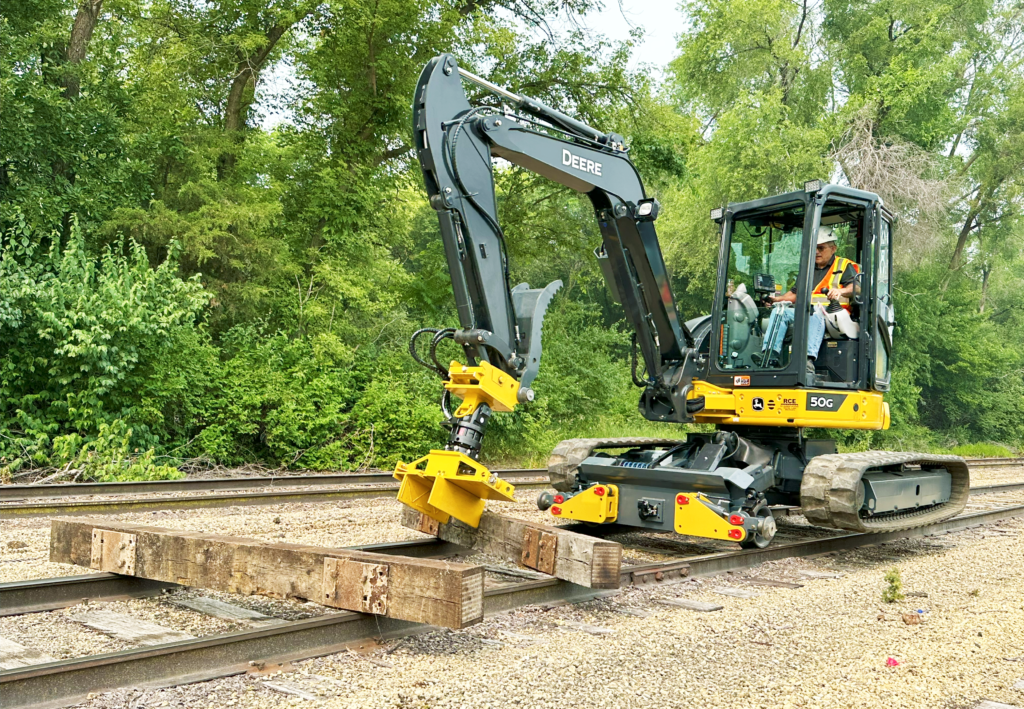
RCE’s Railavators can be equipped with more than 20 attachments. (RCE photo)
Rhomberg Sersa North America
RSNA is a leading provider of ballast maintenance solutions and technologies offering public and private railroads new and innovative solutions in conditional assessment, maintenance planning and delivering the most cost-effective maintenance solution in optimizing the life and performance of ballast and the overall track bed.
RSNA has recently added a Material Handling and Distribution Train (MHDT), which “helps alleviate the ‘bottleneck’ in production-based ballast cleaning activities.” As suggested, the MHDT is a standalone ballast or spoil management train that compromises MFS cars, and power wagons that collectively enable ballast to be loaded, stored, transported, and unloaded and distributed at site.
According to RSNA, the MHDT is designed to operate with the company’s fleet of RM80 high output ballast undercutters to collect track spoil in areas where casting of material from the undercutter is either not practical, or, as becoming more prevalent, environmentally unacceptable. The MHDT configuration is highly adaptable and can also serve as a direct ballast feeder to the ballast cleaner during ballast cleaning, optimizing the overall production process and reducing costs.
Each MFS car having its own internal conveyor system, RSNA says, “allows material to be transferred from car to car; single line ballast cleaning is possible; and removes the costly expense and of taking the adjacent track out of service to accommodate spoil wagons or in challenging but highly critical infrastructure, high populated areas, environmentally sensitive locations, and ‘traditionally difficult’ to maintain locations, such as tunnels.”
RSNA says it is “constantly looking at ways to challenge traditional methods through innovation to deliver more productive and cost-effective solutions for the purpose of delivering a better end outcome for the industry, customers, and the environment with the MHDT being one example.”
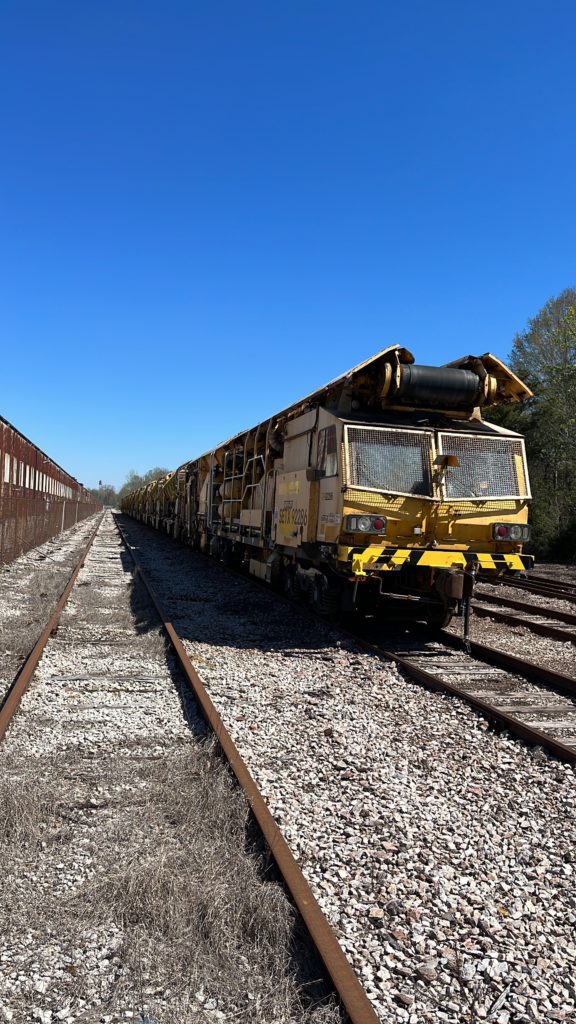
RSNA’s MHDT is designed to operate with the company’s fleet of RM80 high output ballast undercutters. (RSNA photo)
Loram Technologies, Inc.
Research presented at the 2023 AREMA conference highlighted the importance of ballast maintenance for tie life, demonstrating the effectiveness of shoulder ballast cleaning by quantifying the improvement in drainage away from ties during and after rainfall. Analysis was also presented correlating reduced fouling conditions with increased tie life.
Loram Technologies’ customers, both domestically and internationally, are turning to data gathering and analysis to make informed decisions about where to spend their ballast maintenance budgets, the company tells Railway Age. “In the current era, where there is an increased FRA scrutiny of track and limited maintenance windows, a premium is being placed on ensuring that the right work is being done at the locations that need it most. Customers are moving beyond ‘replacing every third tie’ and looking for technology partners that can give them the depth of understanding necessary to ensure that their maintenance dollars will be spent to replace the right ties, and ballast to clean the areas that need it most.”
“Good planning is the key to effective ballast maintenance and understanding the current state of the track is the first step,” the company says. Loram Technologies’ inspection equipment can utilize GPR, LiDAR, line scan, x-ray tie inspection, and video to assess the entire track structure. When this data is aligned with railroad supplied geometry history (to provide overall trending), a complete analysis of the track can be completed and used to inform planning. Loram Technologies says it can partner with the railroad to “develop multi-year maintenance plans to fit with a customer’s budget and remediate/maintain as much track as possible in the most cost-effective manner.”
Tie scans and x-ray data are used to identify which ties are most in need of replacement. Using this data, Loram Technologiesw says it works with customers to build a replacement plan based on current tie condition and budget allocated. With a finalized plan, automated tie painting marks each tie planned for replacement and Tie Set Out (TSO) places new ties at the point of use by the marked tie.
GPR, LiDAR and geometry data are often combined to target where different types of ballast maintenance should be executed. Areas with high-shoulder fouling and moderate crib fouling are candidates for shoulder ballast cleaning alone, while high-center fouling paired with persistent geometry issues may be a target for subgrade stabilization before undercutting. High fouling and moisture retention around bridge abutments, road crossings or switches can be targeted for vacuum excavation.
For example, Loram Technologies says GPR data can be used to identify areas that require undercutting or shoulder ballast cleaning. Total fouling data can then be paired with LiDAR data to plan the ballast cleaning task by identifying the current ballast volume and calculating how much it will be reduced by removing the fouling material. This data can be used to determine how much ballast will need to be delivered to restore the track to the target ballast profile.
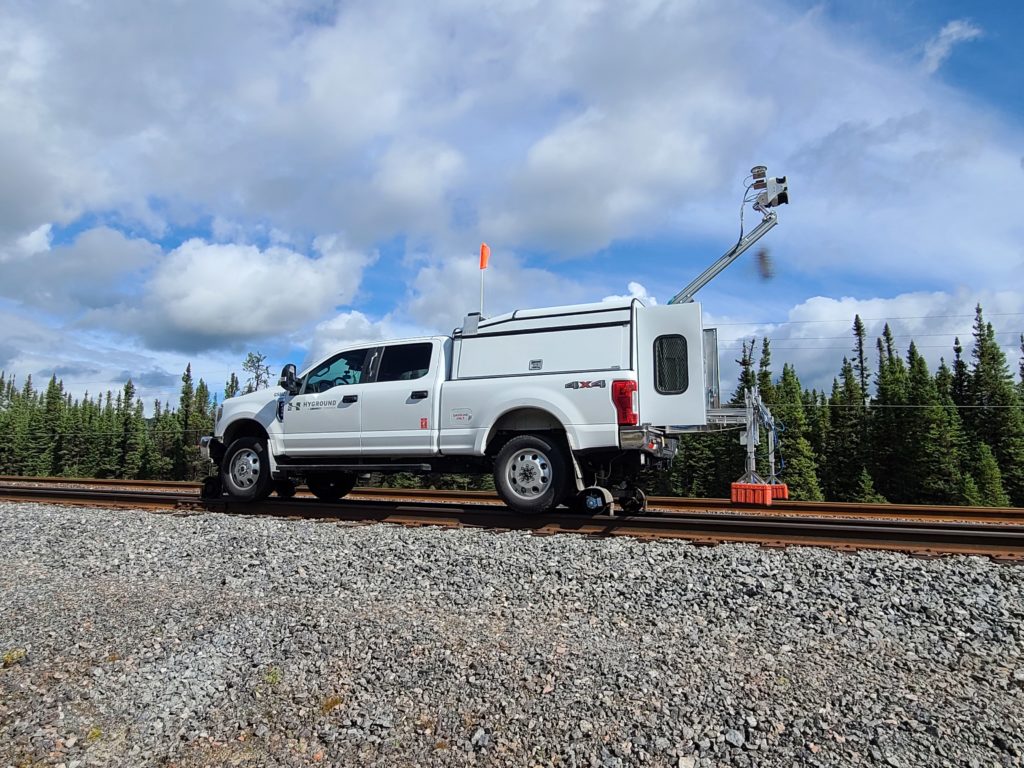
GPR data can be used to identify areas that require undercutting or shoulder ballast cleaning. (Loram photo)

